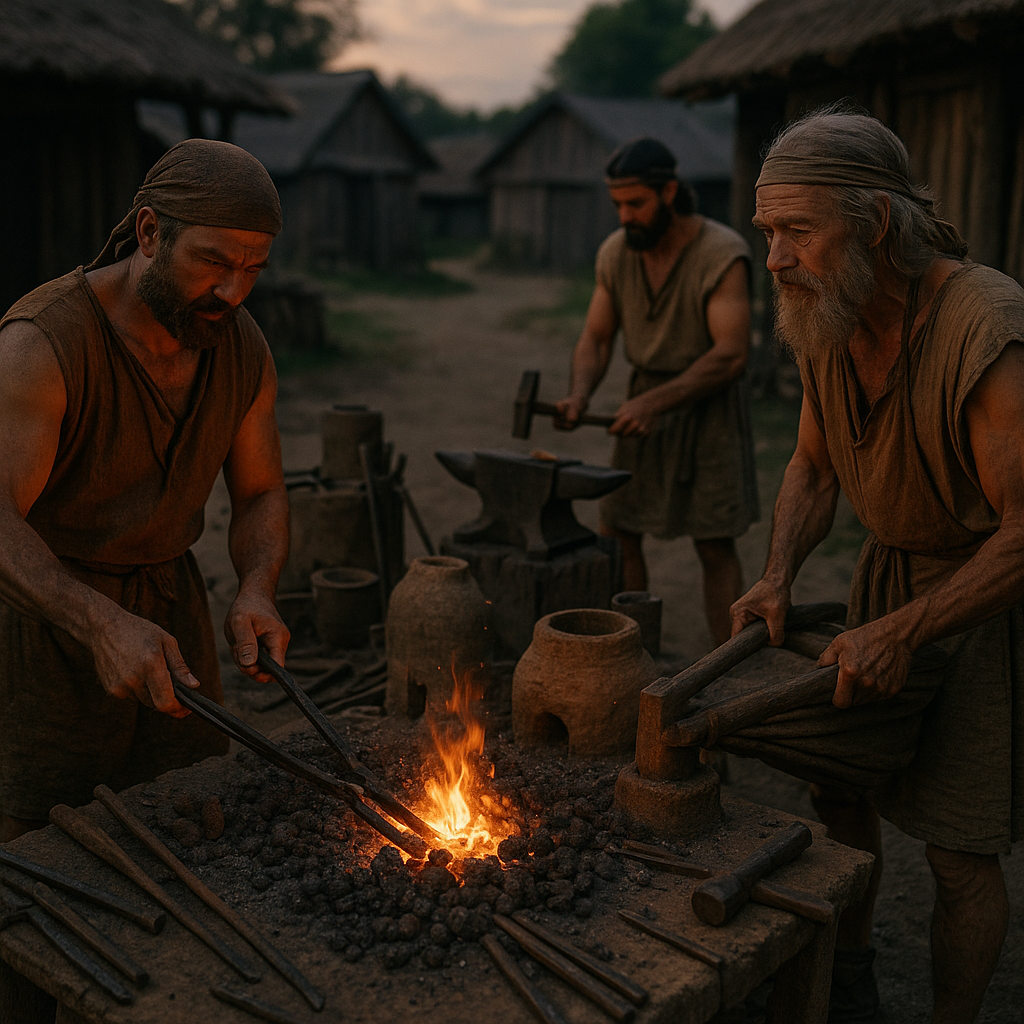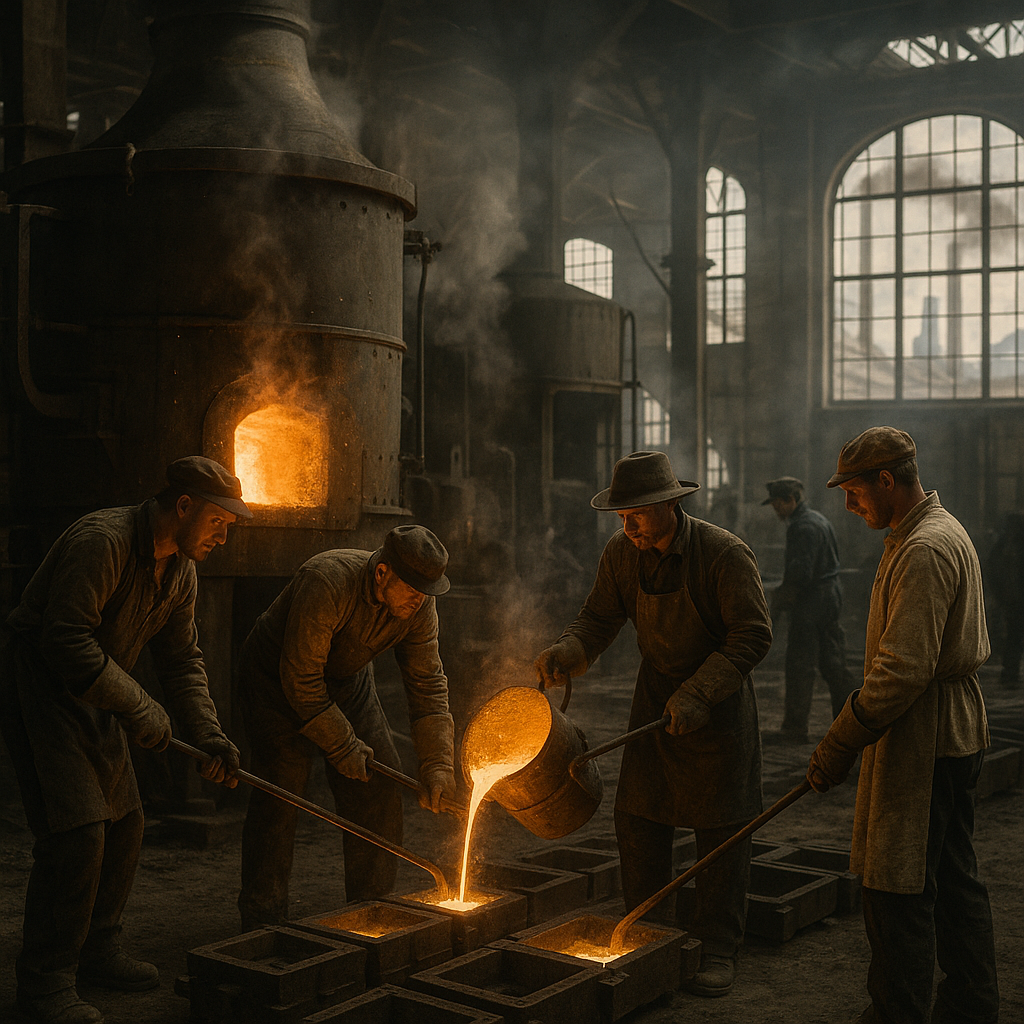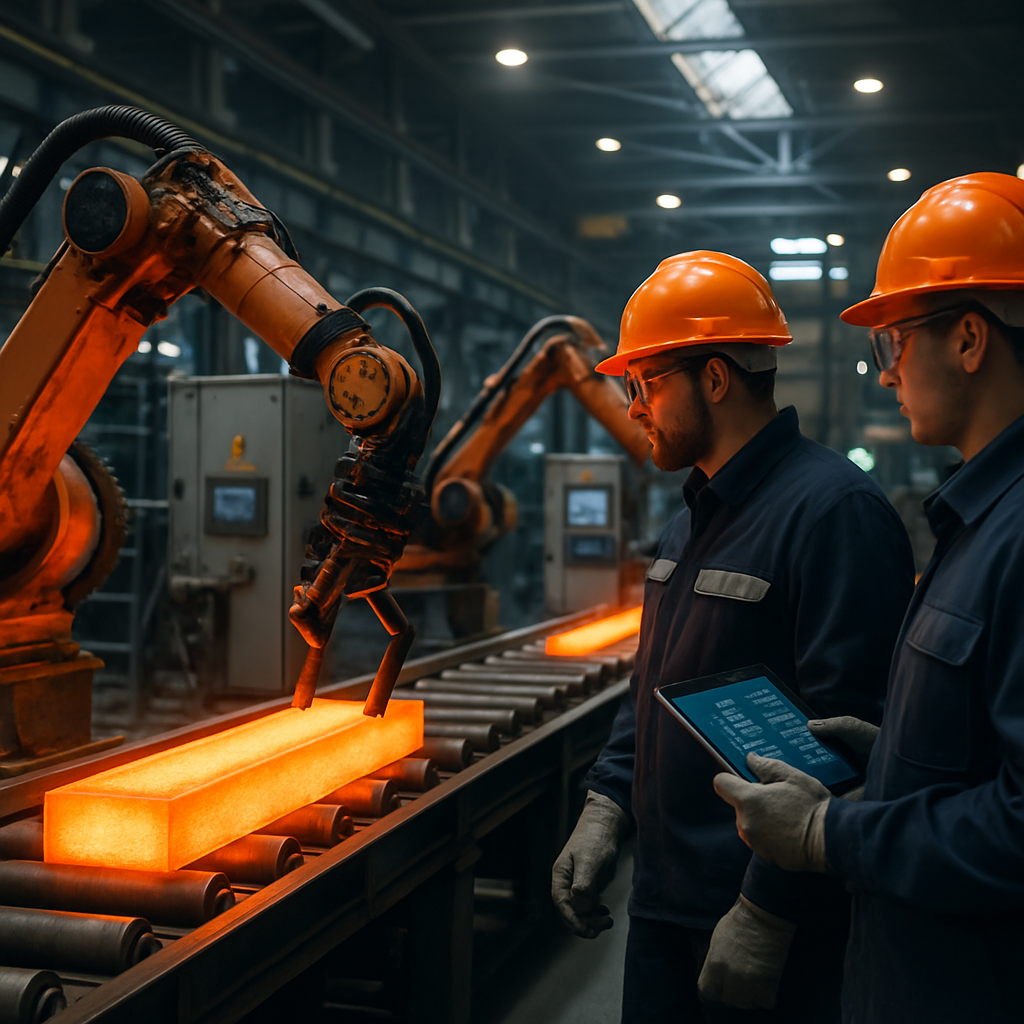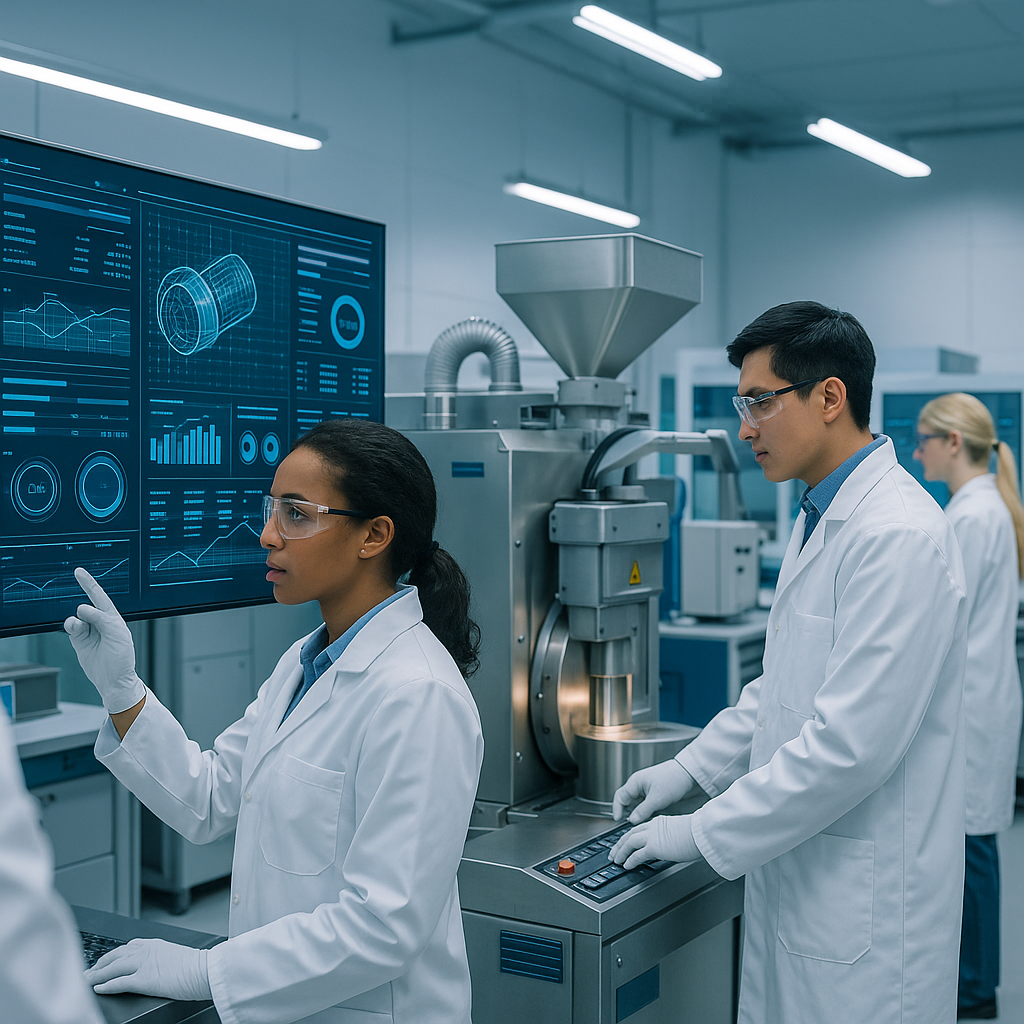5901 Botham Jean Blvd, Dallas, TX 75215
Ferrous Metallurgy: Everything You Need to Know
September 19, 2025Ferrous metallurgy is the science and technology of processing iron and its alloys. It primarily involves the extraction, refining, and transformation of iron from its natural ores into useful materials that have significantly influenced human civilization. The term “ferrous” derives from the Latin word “ferrum,” meaning iron, distinguishing this field from metallurgy involving non-iron metals like copper or aluminum.
The journey of ferrous metallurgy began in prehistoric times when our ancestors first discovered iron from meteorites that fell to Earth. These early metalworkers marveled at the strength and durability of this meteoric metal.
Archaeological findings reveal that the earliest iron artifacts date back to around 4000 BC in Egypt, where iron was initially considered more precious than gold due to its rarity. As techniques advanced, humans developed methods to extract iron from earthly ores, permanently altering the path of technological progress.
How Did Early Civilizations Develop Iron Smelting Techniques?

The journey of iron smelting began around 1200 BC across several ancient civilizations. Early metallurgists in India, Anatolia, and the Caucasus region pioneered techniques that would transform human society and create one of our oldest recycling systems. These innovations laid the groundwork for modern metal recovery processes we still use today.
Early smelting operations centered around bloomeries—simple furnaces where iron ore and charcoal interacted at high temperatures. Workers placed layers of iron ore and charcoal in these clay or stone structures and used bellows to force air through the mixture. The carbon monoxide produced by the burning charcoal reduced iron oxide in the ore to metallic iron, transforming previously unusable earth into valuable metal resources.
Unlike modern furnaces, bloomeries couldn’t reach temperatures high enough to completely melt iron. Instead, they produced a spongy mass called a bloom. Metalworkers would repeatedly heat and hammer this bloom to drive out slag impurities and compress the metal into wrought iron. This labor-intensive process created a malleable but relatively soft metal alloy perfect for tools and weapons.
By 500 BC, Chinese metallurgists had developed far more advanced methods. Their breakthrough came with blast furnaces capable of reaching temperatures exceeding 1100°C. At this heat, iron combined with higher carbon content to become liquid, allowing for casting into molds. This innovation represented the world’s first truly industrial-scale metal production and created two distinct iron products: cast iron and wrought iron.
Cast iron contained 2-4% carbon, making it harder but more brittle than wrought iron. Early civilizations quickly recognized its value for applications where durability mattered more than flexibility. The Chinese used cast iron for everything from agricultural tools to cooking vessels, weaponry, and structural elements. Their mastery of this material gave them technological advantages not matched in Europe for nearly two millennia.
What makes these ancient techniques remarkable from a sustainability perspective is their closed-loop nature. Metalworkers could melt down and reforge damaged or broken iron items into new tools. This established one of humanity’s earliest circular economy systems, where metal resources were continuously recovered and transformed rather than discarded.
Interestingly, the charcoal fuel that powered these early furnaces created environmental challenges similar to those faced today. Ancient iron production consumed vast quantities of wood for charcoal, leading to significant deforestation in some regions. By the 11th century AD, Chinese ironworkers had begun substituting coal-derived coke for charcoal to preserve remaining forests — an early example of resource conservation in industrial processes.
The spread of iron smelting technology across civilizations wasn’t uniform. While China developed cast iron technology by 500 BC, European metalworkers continued using bloomery methods until the medieval period. The secrets of iron working traveled along trade routes, with knowledge gradually diffusing between cultures. Some regions, like sub-Saharan Africa, independently developed unique iron smelting techniques tailored to local resources.
These varied developmental paths remind us that technological innovation isn’t always linear. Different cultures found unique solutions to the challenge of transforming raw materials into useful products based on their available resources and needs. This principle continues to guide sustainable resource management today, where local conditions determine the most efficient recycling and materials recovery approaches.
What Innovations Revolutionized Steelmaking in the Industrial Era?

The Bessemer process, introduced in 1855, dramatically transformed steel production, marking a pivotal advancement during the Industrial Revolution. Prior to this, steel was a luxury, produced in small quantities through labor-intensive methods, making it largely inaccessible. Henry Bessemer’s pioneering converter allowed manufacturers to purify molten pig iron through forced air injection, accomplishing in just 20-30 minutes what previously took days.
This innovation drastically lowered steel prices, dropping from £50-60 per ton to just £6-7 per ton, thereby enabling mass production. The immediate availability of affordable steel revolutionized infrastructure, making it possible to build bridges, railways, skyscrapers, and ships, the cornerstones of modern industrial society.
Bessemer’s process was notably efficient. His converter, an egg-shaped furnace, used high-pressure air to ignite impurities, creating a spectacular display likened to a “veritable volcano in active eruption.” Large converters could yield up to 30 tons of steel in less than 30 minutes, significantly advancing production scale.
Nearing a century later, the basic oxygen process (BOP) elevated steelmaking when introduced in 1952. Swiss engineer Robert Durrer developed, and Austrian companies refined, this method to use pure oxygen, enhancing speed, quality control, and cost-effectiveness. Modern basic oxygen furnaces transform 350 tons of iron into steel in under 40 minutes, a stark improvement over the 10-12 hours previously required.
These innovations reshaped cities and economies. Sheffield, England, earned the nickname “Steel City,” while companies like US Steel and Bethlehem Steel propelled American industrial growth. Affordable, high-quality steel democratized access to goods such as automobiles and household appliances, once exclusive to the affluent.
The environmental impact was significant as well. Earlier methods created striking but polluted industrial landscapes, described by William Cobbett as having “yellow waves of fire that incessantly issue from the top of these furnaces.” Later advancements improved efficiency and lessened some environmental effects, though steel production remains energy-intensive.
Collectively, these breakthroughs revolutionized human capability, enabling the erection of taller buildings, longer bridges, and faster transportation networks. They exemplify how technological advances can catalyze societal change, fostering new possibilities for industrial growth.
| Time Period | Method | Key Features | Impact on Production |
|---|---|---|---|
| Pre-Industrial Era | Bloomery | Simple furnaces using charcoal; produced wrought iron | Low efficiency and small-scale production |
| 19th Century | Bessemer Process | Air blown through molten iron to remove impurities | Enabled mass production and reduced costs significantly |
| Late 19th to Early 20th Century | Open Hearth | Permitted more precise chemical control of the steel | Supplanted Bessemer due to better quality control |
| Mid 20th Century | Basic Oxygen Process | Used pure oxygen, enhanced speed and scale | Further reduced costs, improved quality, faster production |
| Modern Era | Electric Arc Furnace | Utilizes scrap steel; lower energy; flexible | Eco-friendly, adaptable to demand; significant in the US |
How Has Modern Technology Shaped Ferrous Metallurgy?

The landscape of ferrous metallurgy has significantly transformed in recent decades, largely due to Electric Arc Furnaces (EAFs), which stand as a major technological advancement. Unlike traditional blast furnaces that rely on iron ore and coal, EAFs use electrical currents to melt scrap steel and other recycled metals, significantly reducing energy consumption and environmental impact.
The figures are compelling. EAF-based steelmaking now contributes nearly 30% of world steel production, and this figure is expected to grow substantially by 2050. In the United States, over 70% of steel is now produced from scrap steel melted in EAFs, resulting in carbon emissions as low as 14% of those associated with conventional processes.
The rise of EAFs represents a decisive shift in the steel industry’s sustainability approach. By primarily using scrap metal, these furnaces operate with much lower energy requirements than traditional methods. Steel manufacturers globally are increasingly adopting this technology as environmental regulations tighten and consumer demand for sustainably produced steel increases.
Continuous Casting and Computer-Controlled Processes
Apart from EAFs, continuous casting has revolutionized the steel production workflow. This process eliminates the need for traditional ingot casting by enabling molten steel to solidify into semi-finished products in a single operation, resulting in improved yield, higher quality, and greater energy efficiency.
Advanced computer-controlled processes have further transformed ferrous metallurgy. Modern monitoring systems track every aspect of production, from temperature control to chemical composition, allowing real-time adjustments that optimize quality while minimizing waste. The integration of artificial intelligence and machine learning continues to enhance these systems, enabling predictive maintenance and process optimization that was unimaginable just a generation ago.
These technological innovations foster a more flexible production environment. Unlike blast furnaces, which operate continuously, EAFs can be rapidly started and stopped, allowing steel mills to adjust production based on demand fluctuations. This flexibility aligns with modern industrial demands for responsiveness and efficiency.
Specialized Alloys and Material Innovation
Modern technology has dramatically expanded the range of specialized alloys available to manufacturers. Advanced high-strength steels (AHSS) now enable automotive designers to reduce vehicle structural weight by up to 25% while maintaining or improving safety standards. These innovative materials contribute to fuel efficiency and reduced emissions throughout a vehicle’s lifecycle.
The ability to precisely control the steelmaking process has led to alloys with specific properties tailored to unique applications. From corrosion-resistant formulations for marine environments to heat-resistant varieties for aerospace, modern ferrous metallurgy can consistently provide materials that were previously unachievable.
The intersection of computational modeling and metallurgical science has accelerated this innovation. Researchers can now simulate how different compositions and processing methods will affect material properties, drastically reducing development time for new alloys.
| Aspect | Traditional Technologies | Modern Technologies |
|---|---|---|
| Production Method | Bloomery, blast furnace | Electric arc furnace, continuous casting |
| Primary Fuel Source | Charcoal, then coke | Electric power, renewable energy |
| Temperature Range | Up to 1100°C | Up to 1600°C |
| Types of Iron Produced | Cast iron, wrought iron | High-strength steels, advanced alloys |
| Sustainability | High resource input and waste | Recycling-focused, reduced emissions |
Sustainable Practices in Modern Ferrous Metallurgy
Environmental concerns have become a powerful driver of innovation in ferrous metallurgy. Beyond EAFs, manufacturers are implementing numerous sustainable practices throughout the production chain. Water recycling and reuse systems minimize freshwater consumption, while advanced water treatment technologies ensure that discharged water meets stringent environmental standards.
The industry is also exploring the integration of renewable energy sources. Steel plants are increasingly powered by wind, solar, and hydroelectric energy, further reducing the carbon footprint of production. Some manufacturers are even investigating the use of green hydrogen as an alternative energy source for direct reduced iron (DRI) production, which could eventually lead to nearly zero-emission steelmaking.
Closed-loop systems are becoming more common as the industry embraces circular economy principles. These systems aim to minimize waste by recycling and reusing materials within the manufacturing process. The result is not only environmental benefits but often economic advantages through reduced raw material costs and waste disposal expenses.
Challenges and Future Directions
Despite significant progress, the ferrous metallurgy industry faces ongoing challenges. The quality of scrap steel can affect production quality, and high-quality scrap is not always readily available. Implementation costs for advanced technologies remain substantial, potentially creating barriers for smaller manufacturers or those in regions with less capital access.
Looking forward, the continued evolution of ferrous metallurgy will likely focus on further emissions reduction and energy efficiency. Research into hydrogen-based reduction processes shows promise as a potential pathway to carbon-neutral steel production. Additional work on electric furnace technology aims to improve energy efficiency and expand the range of products that can be produced with this more sustainable approach.
The digital transformation of the industry will continue as well. Increased automation, more sophisticated process control, and expanded use of data analytics will further enhance efficiency and product quality. These advancements will not only improve environmental performance but also help manufacturers remain competitive in an increasingly global market.
What is the Future of Ferrous Metallurgy?

The future of ferrous metallurgy is at a pivotal point as the global community strives for sustainability. The steel industry, currently responsible for about 6-8% of global carbon emissions, is undergoing significant changes to meet the needs of a carbon-constrained world. Breakthrough technologies are leading this shift, offering promising methods to drastically reduce the carbon footprint of steel production.
Looking ahead, the successful transition to low-carbon ferrous metallurgy will require collaboration across the entire value chain. For the industry to thrive while meeting climate goals, continued investment in research and development of these promising technologies is essential. The path to sustainable steel production is challenging but achievable with the right combination of innovation, policy support, and market demand.
For comprehensive metal recycling solutions supporting a sustainable future, contact Okon Recycling at 214-717-4083. Our team of experts can help you navigate the landscape of metal recycling and contribute to the circular economy defining the next chapter of ferrous metallurgy.
